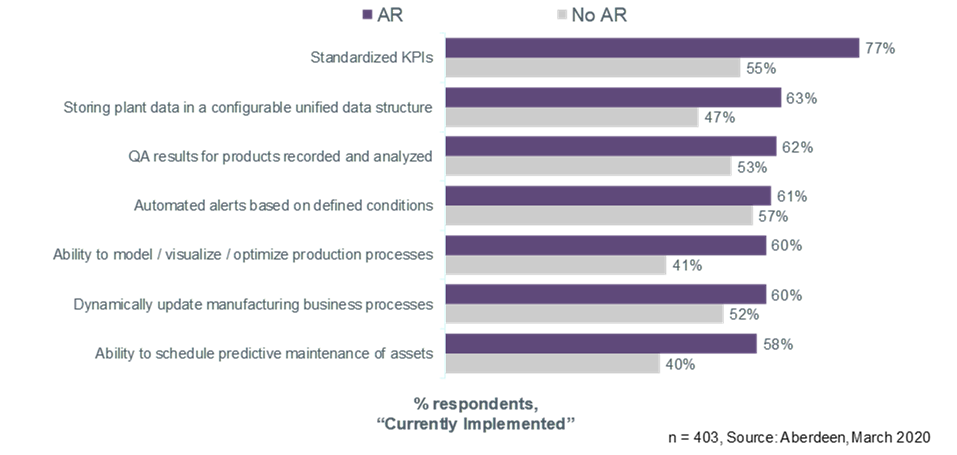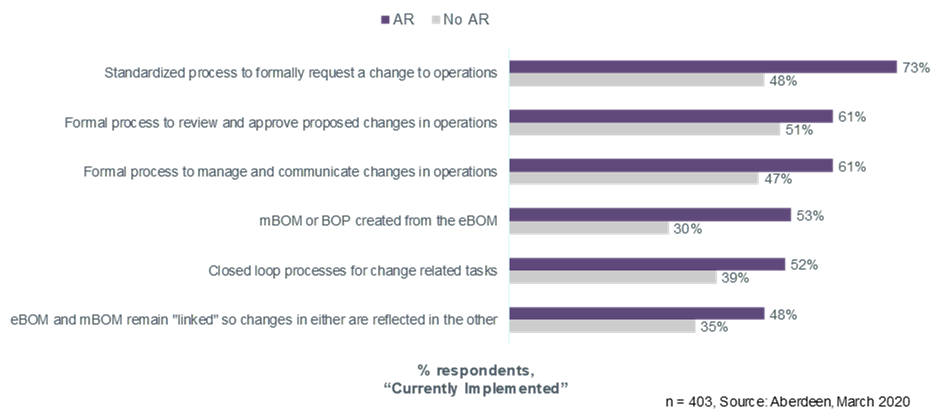From product design, to verification and testing, to maintenance, augmented reality has quickly become a pillar of manufacturing — 63% of Best-in-Class companies are already utilizing it, and 33% of Best-in-Class companies are currently evaluating its benefits and planning to incorporate it into their production processes. AR seamlessly blends technology with real life, and in the manufacturing industry, technological assistance with physical challenges results in immense time and money savings. Over the past two years, augmented reality has helped companies realize a 16% increase in average product ROI and operating margins and a 15% decrease in time-to-decision and manufacturing cycle time.
But there is more to AR than simply monetary results—it is revolutionizing manufacturing operations and business strategies. AR is changing the way employees go about their daily tasks by improving process capabilities as well as change capabilities — two key factors in running an efficient and agile production operation.
AR is Associated with Advanced Process Capabilities
Process capabilities establish standards and methodologies for a smooth relationship between technicians and machines. Now, with the aid of augmented reality, those standards are rising. Companies using augmented reality are breaking away from the pack in a wide range of process capabilities (Figure 1). These capabilities, which AR is strongly associated with, are all related to unification. Normalizing metrics, data structures, and recording procedures can improve workflows across the company and increase efficiency and organization.
Figure 1: Process Maturity Tracks with the Use of AR

Standardized KPIs are extremely useful for reporting and tracking progress. With over a 20% margin between companies using AR and those not, companies with AR are ahead of the competition in their implementation of accurate, cohesive measurement and reporting operations. Having a unified data structure for plant data is another indicator of stable connections across the business. Common data structures allow teams to easily access and utilize different data sources in their calculations with minimal data cleaning, which can be difficult among disparate design, mechanical, assembly, and quality teams. These advanced process capabilities, albeit indirectly related to AR, show that manufacturers who invest in AR are sophisticated in many areas.
Other process capabilities seen in Figure 1 are directly related to AR, such as modelling production processes and predictive maintenance. Visualizing processes with AR software in real time identifies potential areas for improvement and allows organizations to examine and solve internal mechanical issues before more damage can be done. Additional modelling and maintenance capabilities can improve speed and cost-effectiveness within production plants.
Manage Change Effectively
In addition to associations with advanced process capabilities, AR is associated with reliable change management capabilities. Having strong change management strategies proves that companies are prepared to support individuals and teams during development at the organizational level. Providing employees with the tools to welcome change in their everyday activities can lead to greater employee satisfaction, plant productivity, and overall success. According to Aberdeen’s latest manufacturing survey, augmented reality is impacting several key change management capabilities (Figure 2).
Figure 2: AR Bolsters Change Management Capabilities

Companies currently using AR are more likely to have formal processes to request, approve, and communicate change in operations. With one of its main use cases being accelerating operations efficiency, AR can aid in modelling new production flows to minimize downtime, accidents, and maintenance issues. Virtually optimizing workflows allows for efficient change risk analysis and thus more comprehensive change proposals and informed change approvals. Simulations of new assembly line flows and inventory management processes are also much more cost effective than physical implementation tests.
Beyond virtual process evaluation, another critical use case for augmented reality is technician training. As manufacturing processes diversify with digital transformation efforts, workers can quickly adapt with AR-enabled work instructions, empowering them to embrace change. With a greater ability to manage and communicate changes in operations through AR training and instructions, companies can close the skills gap and innovate without delays.
How Manufacturers Can Leverage AR
Augmented reality can impact the operations, culture, and success of a company. But how can companies go about integrating augmented reality into their workflows? The answer is installing manufacturing operations software that connects to AR-enabled devices. Devices manufacturers can use to arm their technicians with augmented reality capabilities include:
- Mobile Devices: 78% and 76% of manufacturers are using or planning to use augmented reality on tablets and smartphones respectively. AR-enabled mobile devices allow technicians to use visual work instructions and analyze operations across the plant.
- Mounted Displays: 70% of manufacturers are using or planning to use AR visors or mounted displays to deploy AR capabilities. These are useful for displaying 3D instructions for hands-on assembly of complex parts.
- Smart Glasses: Only 36% of manufacturers are using or planning to use smart glasses. Similar to mounted displays and AR visors, smart glasses allow the user to view instructions and work hands-free. However, limited features, weak battery life, and high prices may be restricting them from becoming a mainstream manufacturing tool.
An AR-enabled workforce can tackle complex challenges with little initial knowledge, helping employees further themselves and working to minimize the skills gap between veteran and incoming factory workers. Paperless shop floors, optimized process definitions, and intelligent work instructions can propel organizations forward in their digital transformation journeys, boosting them ahead of the competition and into a new era of manufacturing.



